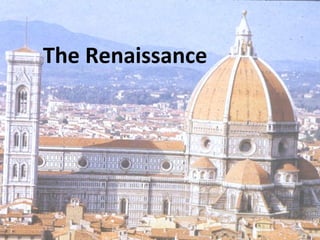
Rennaisance y
- 2. Mongols reopen Silk Road Marco Polo visits China, returns to Europe, writes a book Causes people to want to go there and get Chinese goods Positives of Black Death No damage to farmland, goods, metals People are happy to be alive and spend money to erase memories of the plague Ottoman Turks conquer Byzantine Empire Scholars flee to Italy with ancient texts of the Greeks and Romans
- 3. Early spread (through Italy) Later spread Florence
- 4. Renaissance architects took inspiration from buildings of classic antiquity. The emphasis is placed upon symmetry, proportion, and regularity of parts. Basilica of St Peter, Vatican Rebuild during Renaissance
- 5. Major trading cities: Milan, Florence, Genoa, Venice Florence wealthy from wool and banking Medici family were bankers with political power Hired artists and architects to make Florence great
- 6. Florence Florence, the preeminent Italian city-state in the fifteenth century, was home to the powerful Medici family, whose wealth derived from their considerable banking interests Although the Medici never ruled Florence outright, over the course of 76 years (1418-1494), they moulded and manipulated, controlled and Florence Cathedral. Begun 1296 on original cajoled, persuaded and provoked plan by Arnolfo di Cambio; redesigned 1357 the citizens of Florence and 1366 by Francesco Talenti, Andrea Orcagna, and Neri di Fioravanti; dome 1420-- 1436 by Filippo Brunelleschi; baptistery, late 11th--early 12th century; campanile ca. 1334-- 1350 by Giotto, Andrea Pisano, and Francesco Talenti. Height at bronze ball atop lantern, 350'.
- 10. Pierro della Francesca “View of an Ideal City”
- 15. Essential characteristic of the renaissance art, is that it develops highly realistic linear perspective. Creation of Adam, fresco fragment in Sistine Chapel, Vatican By Michelangelo
- 16. Sculptor, architect, town planner, inventor, engineer, mapmaker, painted Mona Lisa
- 17. According to Vitruvius, if: the human head is 1/8th of the height of an idealized figure then, the human body itself fits into the ideal musical interval of the octave, the interval that gives the impression of duplicating the original note at a higher or lower pitch Leonardo illustrated how the human figure generates both the circle and the square
- 18. wrote poetry, carved sculptures, painted ceiling of the Sistine Chapel
- 20. Title: Interior, Sistine Chapel, Vatican, Rome, Vatican, Rome Source/ Museum: n/a Artist: n/a Medium: n/a Date: Built 1475-1481. Ceiling painted 1508-1512; wall behind altar painted 1536-1541 Size: n/a
- 22. Campidoglio, Michelangelo’s façade, 1537 Rome
- 26. Tempietto 1502 Bramante, Rome
- 27. Tempietto 1502 Bramante, Rome
- 29. Other Famous Domes Il Duomo St. Peter’s St. Paul’s US capital (Florence) (Rome) (London) (Washington)
- 38. Title: Villa Rotonda ( Villa Capra), Vicenza, Italy Source/ Museum: n/a Artist: Andrea Palladio Medium: n/a Date: Begun 1550 Size: n/a
- 39. Title: Capponi Chapel, Church of Santa Felicità, Florence Source/ Museum: n/a Artist: Early Renaissance Chapel by Filippo Brunellschi; Tondos, Murals, and altarpiece by Pontormo Medium: fresco and oil on panel Date: Chapel: 1419-1423. Pontormo, tondos with the four evangelists and mural painting of the Annunciation, on the Size: n/a window wall, 1525-1528; Pontormo, The Deposition, 1525-1527
- 42. Title: Façade of the Church of II Gesù, Rome Source/ Museum: n/a Artist: Giacomo da Vignola and Giacomo della Porta. Medium: n/a Date: Begun on Vignola's design in 1568; completed by della Porta c.1575-84 Size: n/a
- 43. Title: Elements of Architecture: Parts of the Church Façade Source/ Museum: n/a Artist: n/a Medium: n/a Date: n/a Size: n/a
Notas do Editor
- This map shows the spread of the movement. First it developed in Florence in roughly 14 th century, then spread to the remainder of Italy. It didn’t move north yet, for 100 years war raged in northern Europe. When the war finished, Renaissance freely spread north and to Spain and Portugal. But then, Italian states began war with each other, so many remarkable scholars and artists were pushed out into other states, which allowed Northern Renaissance to flourish even more.
- Renaissance architects took inspiration from buildings of classic antiquity. The emphasis is placed upon symmetry, proportion, and regularity of parts. Architecture was an eminent part of the Renaissance, esp in Italy Renaissance architects mainly erected massive cathedrals, chapels, and churches, which shows that despite humanist ideas of the movement, the church was still a strong institution. Buildings were generally built for or requested by and sponsored by the church. In Northern Europe buildings were erected not only for ecclesiastical purposes: the renaissance came to England during the Elizabethan era, and constructions were meant for and sponsored by the crown and served diverse purposes than those of Italy St peters basilica is one of the most well known and breathtaking monument in Italy, and it was rebuilt during the renaissance
- Art was mostly developed by Italian masters, such as Michelangelo and Raphael, and later imitated by masters elsewhere. It is also greatly influenced by classicism. But meanwhile masters apply new techniques, and develop highly realistic linear perspective. They still focus on ecclesiastical themes and Biblical motifs, but at the same time we can see the changing ideas of the era – notes of humanism, changing images. After the Protestant revolution, renaissance masters might have sympathized with revolutionaries, but couldn’t freely express their views for fear of being persecuted by the Roman Catholic church. The only way they had was to indirectly express themselves in their works.
- in cloister of S. Pietro in Montorio,